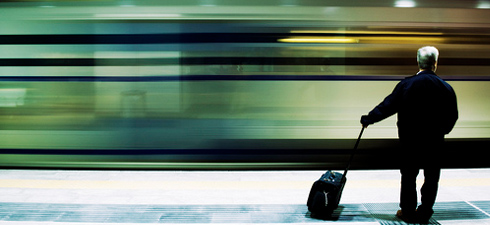Each day, a train 750 metres long leaves Barcelona station in Spain for Lyons in France. It moves at 40 kilometres per hour, which is slow, but speed isn’t the primary virtue of rail freight. It will arrive at its destination in fifteen hours, a journey time only dreamed of a year ago. The line is aging and, in particular, there is a problem with the rail gauge which required moving the freight onto new cars at the French border.
Madrid operates full steam ahead
The Spaniards worked at record speed to fix the rails and, in December, a first convoy of container cars crossed the Pyrenees. Scheduled at three per week at first, there are now seven per week, thus contributing to lower air pollution and reduced road traffic. Today Spain is considering doubling the convoy timetable, convinced that supply will create demand.
Despite a slow start, Brussels thinks that Spain’s infrastructure projects are on the right path. “They are at the heart of the process of continental integration,” the European Commission notes. Next year, a high-speed rail link will arrive in Catalonia and, from there, will directly connect to Madrid. A link with Valencia is expected in 2020 which will then be extended to Cartagena, in the south-east. In the long term, since that is how one must reason, all the Mediterranean ports of the Iberian Peninsula will be linked by a high-capacity line. From there, merchandise can easily be sent to the entire European market and beyond.
The EU experts of [TEN-T](http://ec.europa.eu/transport/infrastructure/index_en.htm <http://ec.europa.eu/transport/infrastructure/index_en.htm), the name given to the Trans-European Transport Networks, are moderately satisfied. They are responsible for the management of thirty priority projects including 11,000 kilometres of roads; 32,800 rail lines and 3,660 waterways. At the end of 2010, they represented a volume of investments of €395 bn of which 62% should be spent by 2013. “For trips of more than 300 kilometres, one third of the freight and passenger traffic must be switched to rail by 2030,” the Commission says. An ambitious project.
The new EU budget
At the end of June, Brussels revised its budget forecast and selected ten projects to promote. In the top four there is the Fehmarn Belt rail link between Copenhagen and Hamburg, the Seine-Escaut canal; the Benner Tunnel (rail link through the Alps between Italy and Austria); and the [Lyons-Turin rail link](http://www.ltf-sas.com/index.php?lg_visite=it <http://www.ltf-sas.com/index.php?lg_visite=it).
Only one, the fourth, is stalled for reasons that have been much discussed in the press for some time and which are not purely economic. The tunnel through the Alps is part of the number 6 axis which links the Rhone River in France to Budapest, Hungary via the Po Valley. Our 750 metre-long convoy should run on it as of 2025, hopes the Commission. The French are counting on it so much that, during the past few weeks, they’ve started imagining a tunnel under Montgenèvre (a village in the French Alps). “The Rhone-Alps region doesn’t want to be left by the wayside,” one hears in Brussels.
In fact, the map of Europe is swarming with on-going construction projects. French president Sarkozy wants the Seine-Northern Europe canal to be operational by 2017 and has just given it the green light. Work at the Brenner Tunnel started in the spring with an expected completion in 2024. The rail tunnel at Saint Gothard has been bored and the tunnel is being consolidated.
Work should be completed in 2017. As for the extension of the Ceneri Tunnel, it is expected for 2019. Is it really necessary? “Look at the Simplon (another Alpine tunnel),” is the response from Brussels, “the two tunnels are already saturated, the newest has 110 convoys per day”. Ditto for the Brenner. The rail lines are overburdened and the motorway is congested.
Bottlenecks in Stuttgart
Belgium, Poland and Germany are in effervescence, which can lead to political friction. A protest movement is blocking the Stuttgart-Ulm project because of the new Stuttgart station which, opponents claim, will upset the urban landscape of Germany’s automobile capital. “A mediation procedure has begun,” the EU notes,” we’ll know the outcome by mid-month”.
The power struggle is followed with great interest in Italy, and particularly in the Piedmont. Project 17 goes through Stuttgart to link Paris to Vienna and Bratislava to Strasbourg. The latter is destined to become the continent’s freight terminal. Convoys will run through Strasbourg from Lyons, and hence Marseilles, and from Geneva heading towards Antwerp or Rotterdam.
In Strasbourg traffic linking the Tyrrhenian Sea to the North Sea will cross traffic linking the Atlantic Ocean to the Black Sea. “Without the Frejus Tunnel, Turin is condemned to become a dead-end,” acknowledges an EU civil servant. The city will become an ancient capital overwhelmed by the West and the East, left outside of commercial flows as of 2030, and thus, doomed to decline.
One can also say that all is well, that’s Brussels’ conclusion, but the consequences must be weighed. Europe, by the will of the Commission and of national governments, is determined to move ahead.
Was this article useful? If so we are delighted!
It is freely available because we believe that the right to free and independent information is essential for democracy. But this right is not guaranteed forever, and independence comes at a cost. We need your support in order to continue publishing independent, multilingual news for all Europeans.
Discover our subscription offers and their exclusive benefits and become a member of our community now!












